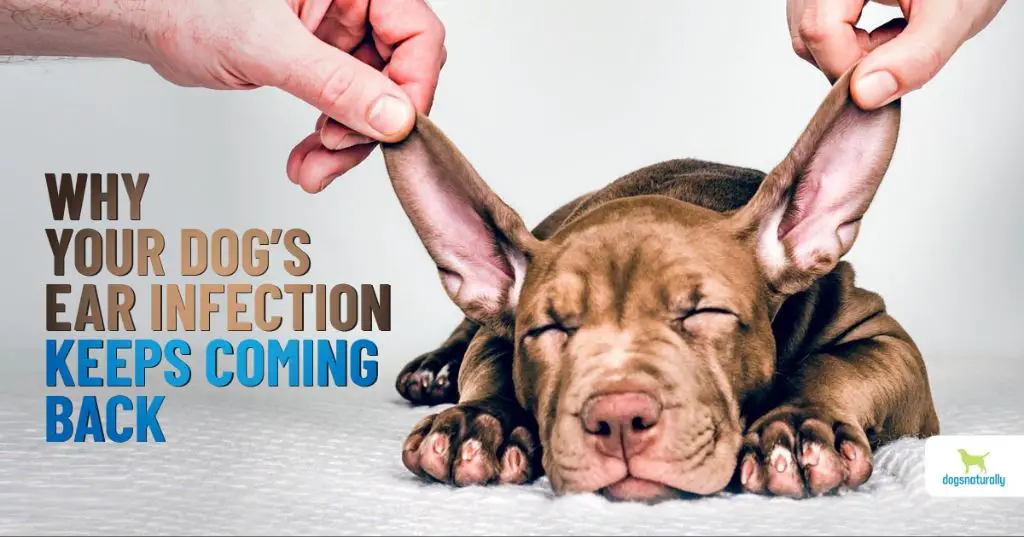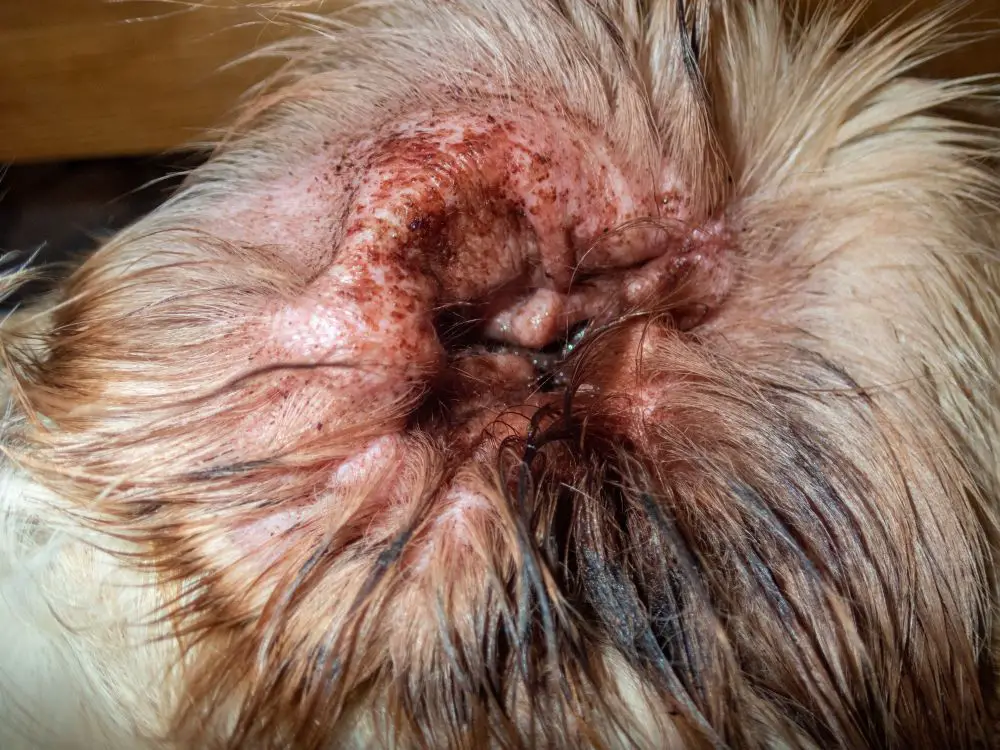Recognizing the Signs of an Ear Infection
If your dog is suffering from an ear infection, there are several telltale signs to look out for. The most common signs of an ear infection include:
Redness inside the ear – The ear canal and inner flap may appear red and swollen. This indicates inflammation.

Excessive scratching or head shaking – Your dog may shake their head or scratch at their ears more than normal. The irritation of an infection causes discomfort.
Odor – There may be a foul, yeasty smell coming from the infected ear due to overgrowth of bacteria and yeast.
Discharge – Infected ears often produce extra wax and fluid, which may be yellow, brown or bloody.
Debris – There may be dark flakes or crusty scabs inside the ear canal from dried discharge.
Pay close attention to how your dog reacts to having their ears touched and cleaned. If they seem painful or sensitive, an infection could be present. The sooner treatment begins, the better the prognosis.
Potential Causes
Ear infections in dogs often develop as a secondary condition resulting from other underlying issues. Some of the most common potential causes leading to ear infections in dogs include:
- Allergies – Allergies to foods, environmental factors, or other substances can cause inflammation and irritation in a dog’s ears. This provides a breeding ground for infection.
- Foreign objects – Things like grass, dirt, seeds, and foxtails can get lodged in a dog’s ears. Trying to scratch out the irritation can cause trauma and damage. This allows bacteria and yeast to invade the ear canal.
- Excess moisture – Dogs with floppy ears or hairy inner ears are prone to developing excess moisture inside their ears. The warm, moist environment promotes yeast and bacterial growth.
- Bacterial and yeast infections – An overgrowth of bacteria or yeast is often the direct cause of an ear infection in dogs. Once established, these microorganisms can cause inflammation, redness, discharge, and pain inside the ears.
By understanding the underlying issue that allowed an infection to take hold, pet owners can take steps to both treat the infection and prevent it from recurring in the future.
Dangers of Not Treating
Untreated ear infections can lead to some serious health complications for dogs. The infection and inflammation can worsen over time, causing significant pain and discomfort. The pressure from the buildup of fluids and debris can also rupture the eardrum, leading to deafness.
In addition to pain and potential hearing loss, leaving an ear infection untreated allows it to spread down the ear canal or into the inner ear. This can lead to a systemic infection, impacting your dog’s overall health. Bacteria and yeast left unchecked can enter the bloodstream.
There is also a risk that the infection could spread to the brain if left untreated for too long. This is very serious and life-threatening. Vestibular disease, meningitis, and other neurological problems could occur.
Bottom line – ear infections won’t go away on their own. Without professional treatment, they will continue to worsen and pose dangers to your dog’s health and comfort. The risks of permanent damage and spreading infection make it important not to delay in getting veterinary attention.

Cleaning the Ears
Gently cleaning your dog’s infected ears can help remove debris and fluid buildup that may be contributing to irritation and inflammation. Here are some tips for cleaning your dog’s ears at home:
Use a cotton ball or pad dampened with a cleaning solution. Apple cider vinegar is gentle and has natural antibacterial properties. A 50/50 mixture of white vinegar and water or a veterinarian-approved dog ear wash are also good options. Hydrogen peroxide can help remove wax and debris, but avoid using it too often as it can irritate the sensitive ear canal skin.
Wipe dirt and debris away from the outer ear, but go no deeper than you can see. Never insert a cotton swab down into the ear canal, as this can damage the eardrum and push debris further in. Be very gentle, stopping if your dog exhibits signs of pain.
After wiping away debris, follow up with a dry cotton ball to absorb excess moisture. This can help prevent bacterial and fungal growth.
Finish by massaging the base of the ear canal to help remove fluid – this can provide relief from head shaking and scratching.
Always reward your dog with praise and treats for cooperating with the cleaning process.
Continue cleaning daily while monitoring for improvement in symptoms. Seek veterinary care if the infection persists beyond a few days.
Treating Pain and Inflammation
Treating your dog’s ear infection when you can’t afford professional veterinary care can still provide relief and improve your dog’s condition. There are some effective over-the-counter options for managing pain and inflammation at home:
Pain Medication: You can give your dog over-the-counter pain medications like acetaminophen (Tylenol) or ibuprofen (Advil). Follow dosing guidelines carefully based on your dog’s weight. Never exceed maximum doses. These medications can cause side effects so use judiciously.

Cold Compresses: Applying a cold compress to the outer ear can help reduce inflammation and discomfort. Wrap an ice pack or frozen vegetable bag in a towel and hold it against the ear for 5-10 minutes at a time.
Calendula Oil: Applying a few drops of calendula oil around the ear opening can have soothing, anti-inflammatory effects without antibiotics. You can find calendula oil online or at most health food stores.
While these treatments may provide some relief, persistent or worsening infections ultimately require professional veterinary diagnosis and care. Trying to manage the symptoms at home should only serve as a temporary solution until you can get veterinary treatment.
Keeping Ears Dry
One of the most important things you can do to prevent ear infections in dogs is to keep their ears dry. This is especially important after swimming or bathing when moisture and water can get trapped in the ear canal.
After your dog goes swimming, be sure to thoroughly dry their ears. Use a clean towel or cotton balls to gently wipe out and absorb any water in the ears. Pay special attention to drying the ear canal and inner flap area. You may need to repeat drying several times to get all the moisture.
When bathing your dog, try to avoid getting water and shampoo in their ears altogether. Use cotton balls placed in the ear opening to block water from entering. If water does get in, take extra time after the bath to carefully dry out the ears.
In general, dogs with floppy ears and hairy inner ear flaps are more prone to moisture retention and infections. After baths and swim time, you may need to use a blow dryer on a low heat setting to fully dry these areas. Just be sure to keep the dryer 6 inches away to avoid damage.
Check ears daily for any signs of dampness or funky smell, which could indicate infection. Keeping your dog’s ears clean and dry is one of the best preventative measures you can take.
Dietary Considerations
Certain dietary factors can increase the risk of ear infections in dogs. Food allergies are a common trigger, as allergic reactions can cause inflammation and excess wax production. The most common food allergens for dogs include beef, dairy, chicken, lamb, fish, eggs, corn, wheat, and soy.
Eliminating potential allergy triggers from the diet and switching to a hypoallergenic dog food may help reduce allergies. Novel protein sources like venison, rabbit, or duck can be good options. Gradually transition food changes over 5-7 days to avoid upset stomach.
Ensure your dog’s food contains nutrients that support healthy skin and ears. Key vitamins include A, B, C, E. Minerals like zinc, copper, essential fatty acids are also beneficial. Consider an omega-3 fish oil supplement which helps reduce inflammation. Probiotics and antioxidants promote overall immune health.
Avoid sugary treats and snacks which can alter pH and promote yeast overgrowth. Stay hydrated by providing fresh, clean water at all times. Check with your vet before making major dietary changes.
When to See a Vet
While many mild ear infections can be treated at home, it’s important to have your dog seen by a vet if certain concerning symptoms develop. You should make an appointment right away if your dog experiences:
- Severe pain or crying/whining when the ears are touched
- Total deafness or sudden loss of hearing
- Tilting of the head or loss of balance
- Vomiting or lack of appetite
- Discharge that smells particularly bad
- Swelling around the ears or face
- Crusting or scabs developing in or around the ear
These signs can indicate a worsening infection, rupture of the eardrum, or spread of infection into the inner ear or facial nerves. Leaving advanced ear infections untreated can lead to permanent deafness, chronic outer ear infections, facial nerve paralysis, vestibular syndrome, or even meningitis. So it’s very important to have your vet examine your dog promptly if any of these more serious symptoms arise.
Vets have specialized equipment to fully evaluate the ears and eardrums. They can also prescribe oral or injectable medications if needed to get the infection under control. While home care has its place with mild infections, rapidly progressing or advanced cases often need veterinary attention and medications.
Preventing Reoccurrence
One of the best ways to prevent ear infections from coming back is to treat any underlying allergies your dog may have. Allergies to foods, pollens, or other environmental factors can cause inflammation and increase the likelihood of infection. Work with your vet to identify allergy triggers and discuss options like anti-allergy medications, allergy shots, or dietary changes to control allergies.

Regular ear cleaning is also important for prevention. Gently wipe the visible parts of your dog’s ears weekly with a dog ear wash or 50/50 vinegar and water solution. This keeps debris and wax from building up. Be careful not to use cotton swabs or go deep into the ear canal, as this can cause injury.
Using a drying agent after baths or swims can help keep moisture out of the ears. There are many over-the-counter ear drops made just for drying and acidifying dog ears after water exposure. Applying these periodically can help prevent the warm, moist environment that encourages bacterial and fungal growth.
Discuss with your vet using a prophylactic ear drop containing antibiotics or antifungals. For dogs prone to infections, using preventive drops routinely can stop infections before they take hold.
Affordable Vet Options
Even if money is tight, it’s important not to delay veterinary treatment for a serious ear infection. There are several options to help pay for care from a licensed vet when finances are limited.
CareCredit and Scratchpay both offer credit cards specifically for pet medical expenses. CareCredit has special financing offers with no upfront costs, interest, or fees for 6-12 months depending on the amount. Scratchpay issues lines of credit from $200-10,000 that can be repaid over 6-12 months.
The ASPCA has a database where pet owners can search for organizations and grants that assist with vet bills based on their location and situation. Local humane societies or rescue groups may also have suggestions for financial assistance programs.
Veterinary schools affiliated with local colleges often offer reduced cost clinics with services performed by students under faculty supervision. These clinics provide an affordable option for basic care and can diagnose ear infections. If the infection is severe, they can refer you to full-service vets who may be willing to offer a discount.
While home treatments can provide temporary relief, a chronic or worsening ear infection really requires a vet’s care. Don’t let cost deter you from getting your dog the medical attention they need. There are solutions to make professional veterinary care affordable.